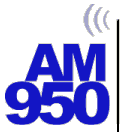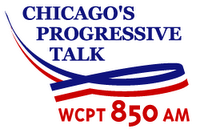As Air America Radio is going through growing pains, and conservative bloggers and radio flacks everywhere have been circling the liberal talk radio format like starving vultures, there is some encouraging news for the format in regard to Arbitron ratings for stations carrying the format.
This past fall was important for the format, as the national midterm elections heated up. And it seems that a few liberal talk stations enjoyed some pretty impressive success. Many others at least maintained their current level of listeners. Granted, the only ratings reports released to the general public are often only the overalls, which consist of all listeners ages 12+ in all dayparts from 6AM-midnight. These numbers, while not as important to advertisers as demographic and daypart breakdowns, do at least give a glimpse of how the format is doing.
In the first of several reports, Part 1 will cover the midwest region of the country. In future installments, LTR will take a look at other areas.
Last Friday, Ed Schultz lashed out at Sean Hannity for comments he made about the liberal talk format, which he claimed was dead. Schultz made it a point to openly remind Hannity that in the most recent ratings book, he actually beat him in several large markets, including Portland, Seattle, Denver, San Francisco, Miami and Albuquerque (mp3). The most notable win was in ranked market #16 - Minneapolis/St. Paul, where Hannity, as well as Rush Limbaugh, took quite a beating. Schultz beat, tied, or came close to clobbering Hannity throughout all the demographic breakdowns of the latest book. Schultz' affiliate, 1,000 watt independently-owned suburban liberal talker KTNF, finished with a virtual tie against Hannity's 100,000 watt FM affiliate, KTLK-FM, which has been heavily promoted over the past year via a $1 million advertising campaign by its owner, Clear Channel Communications. KTLK-FM also serves as the Twin Cities affiliate for Limbaugh's show, though he wasn't much help, since he finished virtually tied with KTNF's Al Franken in the midday shift. Schultz was eager to remind Hannity of the ass-whuppin', and to rub it in the face of his longtime nemesis, Clear Channel regional VP Mick Anselmo, who he blames for trying to stall his radio career. KTNF more than doubled its overall share (all dayparts, ages 12+) from a 0.8 to a 1.7, for 15th place, finishing a mere fifth of a ratings point behind KTLK-FM. The station did well with its morning drive combo of Bill Press and Stephanie Miller, obtaining a 1.9 share, tied for 15th place and beating both local talk stalward KSTP, and more than doubling the ratings of KTLK-FM. KTNF was also the only talk station in the market to actually improve its ratings from the Summer ratings period. The Twin Cities market is saturated with news/talk stations, ranging from the mostly conservative KTLK-FM, full-service legend WCCO, locally-oriented KSTP, Salem conservotalker WWTC, female-oriented WFMP-FM and Minnesota Public Radio's KNOW. Considering the dearth of competition, a much smaller local presence and the limitations of its signal, KTNF has much to be proud of this time around. Congratulations.
KTNF more than doubled its overall share (all dayparts, ages 12+) from a 0.8 to a 1.7, for 15th place, finishing a mere fifth of a ratings point behind KTLK-FM. The station did well with its morning drive combo of Bill Press and Stephanie Miller, obtaining a 1.9 share, tied for 15th place and beating both local talk stalward KSTP, and more than doubling the ratings of KTLK-FM. KTNF was also the only talk station in the market to actually improve its ratings from the Summer ratings period. The Twin Cities market is saturated with news/talk stations, ranging from the mostly conservative KTLK-FM, full-service legend WCCO, locally-oriented KSTP, Salem conservotalker WWTC, female-oriented WFMP-FM and Minnesota Public Radio's KNOW. Considering the dearth of competition, a much smaller local presence and the limitations of its signal, KTNF has much to be proud of this time around. Congratulations. Elsewhere in the midwest, WCPT in Chicago (market #3) has been somewhat of a success story. They're a suburban AM station that signs off the air during the nighttime hours, but they have been making a dent in the lower reaches of the local ratings. For the Fall book, the station is up a fifth of a point, to 0.7. Putting it in perspective, that's not too far behind CBS' Free FM station, WCKG. Across the state, WKBF, which was recently flipped to a Christian-based format by its new owner in December, was tied for tenth place in its final book with a 1.7 share, up from a 0.8 in the Spring book.
Elsewhere in the midwest, WCPT in Chicago (market #3) has been somewhat of a success story. They're a suburban AM station that signs off the air during the nighttime hours, but they have been making a dent in the lower reaches of the local ratings. For the Fall book, the station is up a fifth of a point, to 0.7. Putting it in perspective, that's not too far behind CBS' Free FM station, WCKG. Across the state, WKBF, which was recently flipped to a Christian-based format by its new owner in December, was tied for tenth place in its final book with a 1.7 share, up from a 0.8 in the Spring book. Ohio has been a bit rough for liberal talk as of late. The format was dropped on stations in both Cincinnati (#28) and Columbus (#37), both part of the same Clear Channel regional cluster. In Cincy, WSAI ends its progressive talk run with a 1.0 rating and a 19th place finish, while WTPG ends with a 0.8 share. In Akron, sister station WARF slides a bit, down from a 1.0 to a 0.6 share. The station, however, is still optimistic about the format, and recently tweaked the schedule in hopes of future success. The station also marks its first appearance in the ratings of neighboring Canton (#128), clustered with various Cleveland and Akron stations near the bottom of the book at a 0.4. Nothing earth-shattering here, but it is notable in that this is the station's first appearance in the Canton rankings.
Ohio has been a bit rough for liberal talk as of late. The format was dropped on stations in both Cincinnati (#28) and Columbus (#37), both part of the same Clear Channel regional cluster. In Cincy, WSAI ends its progressive talk run with a 1.0 rating and a 19th place finish, while WTPG ends with a 0.8 share. In Akron, sister station WARF slides a bit, down from a 1.0 to a 0.6 share. The station, however, is still optimistic about the format, and recently tweaked the schedule in hopes of future success. The station also marks its first appearance in the ratings of neighboring Canton (#128), clustered with various Cleveland and Akron stations near the bottom of the book at a 0.4. Nothing earth-shattering here, but it is notable in that this is the station's first appearance in the Canton rankings.
In Detroit (#10), WDTW, hampered by a rather weak signal and heavy competition, holds at a 0.5, just a tenth of a point behind high-powered Canadian talker CKLW (the local George Noory/Art Bell affiliate). They're also a tenth of a point ahead of Salem's conservotalk WDTK. In nearby Ann Arbor (#147), WLBY comes in with a 1.5 share, in a six-way tie for 17th place, with local talker WAAM and several Detroit FM stations, including the local affiliate of CBS' struggling "Free FM" talk format.
UPDATE: In several late-arriving market reports, Duluth/Superior's KQDS, a tiny AM with no web presense and virtually no promotion whatsoever (like many other stations in the market), makes a rather impressive jump from a 0.9 in the Spring to a 2.1 share for the Fall. WXXM in Madison, recently saved by grassroots supporters, holds somewhat steady with a 3.4 share, down slightly from 3.7 in the ratings period that ended in mid-December. And in Grand Rapids, WTKG is still just under a share.
Note that ratings surveys do not take into account listeners to online streams. Also, the way ratings are reported will change considerably in the coming year, as Arbitron is moving toward doing away with the old 'pencil and paper' diaries and moving toward electronic means, such as online reporting and 'peoplemeters'. The hope is that this will give a more concise figure as to radio listenership. Arbitron also plans to include non-commercial stations, such as NPR affiliates, community and college stations, and non-commercial religious outlets in the overall rankings. Currently, the publicly-released figures include only commercial outlets, though they do track non-coms and include them in some breakdowns.
This is only the first in a series of pending ratings reports you'll see here at LTR, as there are so many stations to report, and not all markets have gotten their Fall '06 books yet. In future installments, you'll see how stations in other parts of the country fared.



Thursday, January 25, 2007
Ratings Roundup Fall 2006: Part 1
Subscribe to:
Post Comments (Atom)




 Eureka, CA
Eureka, CA 

0 comments:
Post a Comment